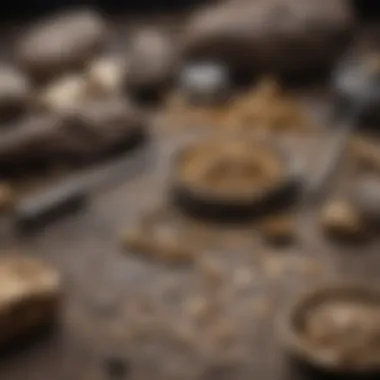Essential Tools for Gold Prospecting Success


Intro
In a world where the allure of gold stands as a testament to both avarice and achievement, understanding the tools needed to uncover this precious metal becomes paramount. Gold finding kits are not merely a collection of implements but are gateways to adventure and discovery. They hold the potential to transform a casual stroll through nature into a treasure hunting expedition. Learning about the components, techniques, and safety considerations associated with these kits is vital for both fledgling and seasoned prospectors.
The journey into gold prospecting begins with an appreciation of history, where miners and adventurers faced untold challenges while searching for fortunes. Today, with advancements in technology and a wealth of knowledge at our fingertips, anyone can delve into this age-old pursuit. This guide aims to elucidate the essential elements that make up a gold finding kit, ensuring that readers are equipped with not only the tools but also the understanding necessary to embark on their own treasure-hunting odyssey.
History and Origins
Gold has always fascinated humanity, from its use in ancient jewelry to being a standard of wealth and power. Prospecting for gold has a rich history that dates back thousands of years. It is not just about the metal itself, but also about the cultures and communities that spring up around gold mining.
Overview of Gold Prospecting
The practice of gold prospecting evolved markedly over the centuries. In the early days, it was simply a matter of washing sediment from riverbeds, often yielding nuggets or flakes that glinted in the sunlight. This primitive method laid the groundwork for more sophisticated techniques.
As explorers expanded into uncharted territories, such as during the California Gold Rush of the mid-1800s, prospecting shifted from basic panning to more elaborate methods like sluicing and dredging, enabling miners to extract larger quantities of gold.
Historical Significance and Cultural Impact
Gold rushes have shaped societies and influenced migration patterns. For instance, the Klondike Gold Rush drove thousands to the harsh terrains of Canada, adjusting their lives entirely for just a sliver of hope. These events fostered communities, led to the establishment of laws, and dramatically altered local economies. Today, prospecting is not only a nod to that past but also an exciting hobby for many. It reminds us that there are still uncharted territories within nature, with the potential to change one's fortunes—even if only for a fleeting moment.
"Gold is the most powerful of all metals and has been sought after since ancient times."
Identification and Classification
To embark on any successful prospecting venture, one must first understand what they are searching for. A gold finding kit contains various tools designed for identification and classification of materials found in nature. Knowing how to identify these can save time and increase efficiency.
Guide to Identifying Gold
Gold can be tricky to locate amidst an array of rocks and minerals. Here are key identifiers to look out for:
- Color and Luster: Authentic gold has a distinct buttery yellow hue and tends to shine in a reflective manner.
- Density: Gold is notoriously heavy; if it feels light, it's likely not gold.
- Malleability: Gold can be easily shaped, which is a handy test to perform in the field.
Common Types and Variations
Not every shiny fragment is gold. Understanding common alternatives is crucial. Among the most frequently confused materials are:
- Fool's Gold (Pyrite): Often mistaken for real gold, it has a brassy yellow color and is far less valuable.
- Mica: This mineral can sparkle like gold but it's softer and easily crumbles.
- Copper or Brass: These metals can sometimes shine brightly and could mislead a novice prospector.
By familiarizing oneself with the various forms of material found in prospecting, one enhances their ability to maximize the benefits of their gold finding kit, leading to more successful outings.
Prelude to Gold Prospecting
Gold prospecting is much more than just a hobby; it's an adventure steeped in history and excitement. The act of searching for gold invokes a sense of exploration, where individuals embark on a journey that connects them with nature and the rich legacies of the past.
Understanding the importance of gold prospecting lays the foundation for any enthusiast, whether a beginner or a seasoned prospector. It goes beyond simply discovering shiny pieces of metal; it's about understanding the geological processes that led to gold deposition, the local ecosystems, and the historical economic significance of gold itself.
Historical Context
Gold has captured the human imagination for centuries. From ancient civilizations that worshiped it as a divine element to the frantic gold rushes of the 19th century, its allure has motivated countless explorations. Take a stroll down memory lane to the Klondike Gold Rush—an episode that transformed not just the landscape but entire societies. Here, thousands flocked to the remote terrains, not just in pursuit of wealth, but in a quest that reshaped their identities.
These historical narratives matter in the present context. They remind modern prospectors of the strategic approaches used by their ancestors. Knowing where to search, the tools they utilized, and the environmental factors at play can lead to a richer experience when panning or digging for gold today.
Modern Gold Searching Techniques
With the advent of technology, gold prospecting has transcended the rudimentary methods of yesteryears. Nowadays, modern techniques incorporate a blend of traditional skills with advanced tools.
- Metal Detectors: These devices have revolutionized the game. No longer is one confined to water bodies and riverbeds. Metal detectors allow for targeted searches, enabling prospectors to scan larger areas with precision.
- Geological Mapping: The understanding of geology plays a big part in successful prospecting. Identifying areas with historical gold finds can increase the chances of a fruitful venture.
- Suction Dredging: In places where water flow is available, suction dredging has become a favored method. It ensures that even nooks and crannies under the water are thoroughly explored, allowing prospectors to access hard-to-reach spaces.
- Panning Techniques: While it may seem straightforward, mastering the art of panning is essential. It involves the skillful separation of lighter materials from heavier ones, allowing gold to come to the top.
In summary, while the heart of gold prospecting remains the same—the thrill of discovery—how prospectors approach their ventures today has evolved considerably. Combining historical lessons with modern techniques enhances the experience and effectiveness of the search.
Understanding Gold Finding Kits
Gold finding kits are indispensable tools for anyone who wants to immerse themselves in the art of gold prospecting. These kits combine essential items that make the searching-and-seeking journey more efficient and, may we say, enjoyable. By understanding these kits, you can elevate your treasure hunting experience, enabling you to maximize your efforts and increase your chances of striking gold.
Definition and Purpose
At its core, a gold finding kit is a collection of tools specifically curated to assist in finding and collecting gold. This helps a novice enthusiast become more organized, while also staying equipped for various scenarios one may encounter in the wild. The overarching purpose is to streamline the prospecting process, simplifying everything from the searching phase down to the actual extraction of gold particles from the ground or streams.
Key Components
To truly grasp the significance of a gold finding kit, it’s crucial to know its key components. Each tool serves a specific function, working harmoniously to optimize the gold finding experience.
Pan


The gold pan is perhaps the most recognizable tool in any gold finding kit. It features a wide, shallow bowl-like design, allowing water to wash away lighter materials while retaining the heavier gold nuggets. What makes the pan stand out is its distinct riffles, which trap gold particles within the pan, making them easier to gather.
Many folks consider it an essential 'starter' tool as it requires little investment while delivering significant results. With options ranging from plastic to metal pans, each has its pros and cons—plastic is lightweight and less prone to rust, but a metal pan can generate more tactile feedback during panning.
Classifier
A classifier is a screening device that separates materials by size before actual panning takes place. Often made from woven mesh screens, its role in a gold finding kit is crucial for efficiency. The beauty of a classifier lies in its ability to streamline your efforts: it helps to get rid of the larger stones and debris that would otherwise complicate the panning process.
For many prospectors, having a classifier saves time and energy, allowing them to focus on what really matters—digging for gold. While classifiers come in various sizes, a popular choice tends to be the finer mesh screens, even though they can slow down the processing of material.
Scoop
The scoop is a handy tool that further expedites the efficiency of collecting materials. It's instrumentally designed to pick up sediment and soil, making it a practical addition to any gold finding kit. Scoops are particularly suited for shifting through gravel beds, particularly in streams. A well-designed scoop is solid yet lightweight, making it easy to maneuver without causing backaches.
What many prospector appreciate about scoops is their versatility to adapt to different environments. However, it’s crucial to find one with a suitable cup size relative to your search area; otherwise, you may find yourself overexerting with too large a scoop or dealing with inefficient collection.
Pick and Shovel
The classic duo of a pick and shovel is essential for any serious gold seeker. A pick allows for breaking up hard soil or rocks, while a shovel lets you collect the loosened material for further panning. Their importance in a gold finding kit cannot be overstated; if you’re working in a location with harder terrain, these tools become your best friends.
Typically crafted from durable metals, both tools can withstand rugged conditions, but you may want to consider pick and shovel weight, as a cumbersome pair might tire you out faster than anticipated. Some might opt for smaller, lightweight choices that are easier to carry around.
Magnet
In the peculiar adventure of gold prospecting, a magnet is an often-overlooked tool but one that can yield surprising benefits. It can help you sort through soil and gravel to quickly remove items made of iron or steel, which are not your target. This ensures that you are left with a cleaner base material to work with when panning, which is essential for efficiency.
Its compact size makes it easy to carry along, but people often disregard it. For those serious about maximizing their prospecting workflow, a magnet offers an edge in the competitive world of gold finding.
By familiarizing yourself with each of these components, you can appreciate how they contribute to a gold finding kit. Each has its unique characteristics, not just in function but also in their advantages and the more nuanced challenges they present. Together, they transform what could be a daunting task into a more manageable and rewarding endeavor.
Choosing the Right Kit
Choosing the right gold finding kit can make or break your prospecting adventures. With various tools and equipment available, understanding the specifics of your potential purchase is essential. Factors such as your experience level, budget constraints, as well as the location and terrain where you'll be searching, play pivotal roles in this process. Picking a kit aligned with your needs not only boosts your chances of success but also enhances the overall enjoyment of gold prospecting. Let’s dive into these factors a bit deeper to find out what's most important.
Factors to Consider
Experience Level
Your experience level is the foundation upon which your prospecting journey builds. If you’re just stepping into this world, a beginner's kit containing basic tools will serve you well. It's designed for individuals with little to no experience, featuring user-friendly items that facilitate learning without overwhelming you.
On the other hand, seasoned prospectors may want to explore advanced kits packed with specialized tools to tackle intricate techniques. Beginners might feel intimidated by complex equipment, while experts often seek durable gear that can withstand heavy use.
Advantages:
- Beginners can quickly grasp panning techniques with simple tools.
- Experienced prospectors benefit from specialized equipment that aligns with their skill set.
Budget Constraints
Next comes the budget issue, which everyone encounters to some extent. Kits vary widely in price, and it's important to understand what fits within your financial limitations. You can find basic kits at lower prices but may sacrifice some quality. On the flip side, investing in a top-tier kit may offer premium materials and features.
Be cautious, since a more expensive kit doesn't always equate to better performance. Sometimes, a mid-range option is all you need to get started effectively. Hence, evaluating your spending capacity while weighing your needs is crucial.
Advantages:
- There are options available for every budget, ensuring accessibility for novices and seasoned pros alike.
- Mid-range kits often provide a balance between price and quality.
Location and Terrain
The location and terrain can dictate not just where you can find gold but also how you will search for it. Are you heading to a riverbed with fast-moving water, or are you looking in rocky terrains? Different environments call for different tools which can be included in your kit.
For instance, a kit suited for river prospecting may require a larger pan and a heavier scoop, while one meant for hiking up rocky hills might need a pickaxe and more portable gear. The unique landscape can dramatically alter the tools necessary for a successful outing.
Advantages:
- Choosing the right kit for specific environments increases efficiency in gold prospecting.
- Tailored tools can enhance safety and comfort during exploration.
Top Brands and Manufacturers
When you're in the market for a gold finding kit, recognizing reputable brands is crucial. Companies like Garrett, Fisher, and Le Trap have established their names through quality products and reliability. Each brand often has a distinct focus, so knowing what you prefer can significantly narrow down your choices. For instance, Garrett is notably recognized for its metal detectors, while Le Trap's sluice boxes have garnered significant attention among enthusiastic prospectors. Exploring brand reputations, reading reviews, and engaging with community forums can also offer insights into the most efficient tools available, enhancing your treasure-seeking experience.
Techniques for Effective Gold Finding
When it comes to gold prospecting, the right techniques can make all the difference. Just having a gold finding kit is not enough; knowing how to use it effectively is crucial for maximizing your chances of success. This section sheds light on various methods that prospectors can adopt, balancing traditional approaches with newer technologies, ensuring a comprehensive understanding of the art and science behind finding gold.


Panning Basics
Panning is often considered the most fundamental technique for gold prospecting. It’s where every hopeful prospector begins, likely because it doesn't require much investment to get started. You use a simple gold pan to separate gold from dirt and gravel. The key here is to understand the angle and motion—you need to hold the pan at a slight tilt and use a swirling motion, which helps the denser gold particles to settle at the bottom.
However, it’s not just about swirling. You must be patient and work through the material meticulously. Often, it's useful to familiarize yourself with your local waters—are there spots where gold tends to accumulate? Maybe near rock outcrops or in natural riffles. Practicing your panning technique often leads to improving your speed and efficiency, cementing this method as a staple in your gold-finding toolkit.
Using a Metal Detector
Metal detectors have revolutionized gold prospecting, giving enthusiasts the ability to search vast areas without intensive manual labor. The beauty of metal detecting lies in its technology; it helps to identify metals beneath the surface, saving a lot of time and effort. However, not all metal detectors are created equal.
When considering a metal detector, you want one specifically designed for gold. These machines are more sensitive and usually able to discern the fine gold nuggets from trash metals like iron or aluminum. Like people say, "You get what you pay for." Investing in a decent detector can up your game significantly.
Now, here’s a pro tip: scout areas that have seen little previous prospecting activity. Old mining areas often yield hidden gems—but do your homework first on legality and permissions to avoid stepping on toes. Take note of the ground surface and dig only when your detector gives a confident reading. Slow and steady wins the race.
Suction Dredging Techniques
Suction dredging is a game-changer for many gold prospectors. This involves using a specialized machine that vacuum up material from the river or streambed, separating gold from soil and gravel on the go.
While it might sound complicated, the principle is fairly simple. The dredge operates by sucking water, gravel, mud, and gold into a hose, through a classifier, and into a recovery system which captures the desirable materials. It’s efficient, to say the least; many users find it’s easier and more productive than traditional methods. However, there are a few things to keep in mind.
First, check local regulations. Some places have strict rules on dredging, while others may prohibit it entirely; it’s easy to overlook these details until it’s too late. Also, make sure you have the right permits if required. Secondly, understand the environmental impacts. Dredging can disturb ecosystems, and being conscientious will enhance your reputation in the gold-finding community.
"A tool is only as good as the person wielding it." The methods you choose should align with your goals and the specific conditions of your prospecting area.
Safety Considerations in Gold Prospecting
When it comes to gold prospecting, safety isn't just a checkbox on a list; it's the very bedrock of any successful outing. Understanding and mitigating risks is as essential as having the right tools in your gold finding kit. This section dives deep into the elements that contribute to safe prospecting, focusing on both environmental concerns and personal safety gear.
Understanding Environmental Concerns
Every gold prospector has a responsibility to protect the natural world while pursuing their golden dreams. This isn’t merely about following the rules; it’s about safeguarding the areas you treasure. Soil erosion, habitat destruction, and pollution can result from careless prospecting practices. Here are a few key points to consider:
- Respect Local Wildlife: Disturbing animal habitats can have far-reaching effects. Always observe local regulations regarding wildlife and refrain from digging or damaging natural habitats.
- Stick to Designated Areas: Many regions have specified areas for prospectors. Straying from these zones can damage ecosystems. Familiarize yourself with local laws and maps to ensure compliance.
- Leave No Trace: The ethos of leaving nature as you found it is crucial. Dispose of waste properly, and if you spot litter, pick it up. Remember, every little bit helps!
"The beauty of nature is a gift that cultivates appreciation and gratitude". – Anonymous
Being mindful of your surroundings not only preserves the environment but can also enhance your experience. Nature is more enjoyable when you know you’re helping to keep it pristine.
Personal Safety and Gear
Equipping yourself with the right gear is paramount when gold prospecting. Safety gear protects both your physical well-being and enhances your enjoyment. From the ground up, here's what you should consider:
- Footwear: Invest in sturdy, waterproof boots with good traction. Slippery surfaces or rocky terrain can lead to serious injuries if you're not careful.
- Protective Clothing: Wear long sleeves and pants, ideally made from durable materials. These protect against scrapes and insect bites that can be all too common in nature.
- Sun Protection: Hats, sunglasses, and sunscreen are crucial for prolonged exposure. The sun doesn’t discriminate, so shielding yourself from sunburn can prevent discomfort in the field.
- First-Aid Kit: It’s always smart to have a basic first-aid kit on hand. You never know when a blister or scratch can turn an enjoyable day into a hassle.
- Communication Devices: If you’re heading out alone or to remote areas, having a reliable way to contact someone is essential. Stone throws are great, but cell phones or two-way radios can be lifesavers in emergencies.
Caring for Your Gold Finding Kit
Caring for your gold finding kit is not just about keeping your equipment in good condition; it’s essential for ensuring your success in prospecting. Like any hobby or venture, dedication to maintaining your tools can yield great rewards. A well-cared-for kit not only performs better but also extends its lifespan, saving you money in the long run. Furthermore, investing time in proper care reflects respect for your craft and can enhance your overall experience while hunting for gold.
Proper Storage Techniques
Storing your gold finding kit properly is crucial to its longevity and functionality. Here are some practical tips to keep in mind:
- Temperature Control: Avoid extreme temperatures. Excessive heat or cold can warp tools and compromise their effectiveness. A cool, dry area is ideal.
- Organized Storage: Use a dedicated container or toolbox. Keeping everything organized not only saves time but also prevents tools from getting damaged or lost.
- Avoid Moisture: Rust is a prospectors' worst enemy. Make sure the storage area is free from dampness. Silica gel packs can help absorb any excess moisture inside your kit.
- Identify and Label: If you have multiple tools, label their locations. This helps library down the time you spend searching for the correct items when you're ready to head out.
Maintenance Tips
Regular maintenance ensures that each component of your gold finding kit serves its purpose effectively. Here are some tips to keep everything in optimal condition:
- Inspection: Periodically check your tools for signs of wear or damage. Don’t wait until you’re deep in the wilderness to notice that your pan has a crack in it.
- Cleaning: After each use, give your tools a good cleaning. A simple rinse will remove dirt and debris, which can lead to quicker deterioration.
- Lubrication: For metal tools, applying a light oil can prevent rust and make them work more smoothly. It’s a simple step, but it goes a long way in maintaining their functionality.
- Adjustments: Always ensure that moving parts of your tools are functioning properly. If something feels loose or isn’t working as expected, fix it right away instead of putting it off.
In prospecting, just as with life, attention to detail can lead to unexpected treasures.
By adopting these storage and maintenance practices, you're more likely to find success in your gold-finding adventures. A well-kept kit not only enhances your enjoyment but also supports your skills as a prospector.
Case Studies and Success Stories
In the world of gold prospecting, real-life experiences can provide invaluable insight. This section focuses on Case Studies and Success Stories, offering both inspiration and practical lessons for keen prospectors. By examining how different individuals have approached their gold-seeking adventures, one can glean techniques and strategies that might otherwise be overlooked. These narratives not only highlight the thrill of discovery but also emphasize the importance of research, patience, and community.
Local Prospecting Adventures
Local prospecting stories are often where the heart of gold hunting lies. They can show the diverse environments in which gold can be found, from small streams to vast deserts. For example, consider a group of amateur prospectors who frequented a creek in California known for its history. After months of weekends spent sifting through sediment and learning the lay of the land, they struck paydirt. The excitement of their find wasn’t just in the gold itself but in the camaraderie formed during late-night campfires discussing techniques and sharing tips.
A key takeaway from such local adventures is the significance of knowing your area. Many prospectors have documented their journey online, sharing maps, locations, and stories about where they found flecks of gold or even nuggets. These accounts can often be found on forums such as reddit.com, where prospectors exchange unique local experiences.


Keeping track of local laws is also crucial here. In one instance, a well-meaning group inadvertently set up in a protected area and faced hefty fines. Staying updated on regulations is a must for anyone involved in prospecting. To avoid pitfalls, check local resources or speak with experienced prospectors in your region.
Notable Discoveries
Notable discoveries in gold prospecting serve as beacons of possibility for both novices and experts alike. For instance, the story of John Sutter and the discovery at Sutter's Mill in the 1840s reshaped the American West. Similarly, modern prospectors have unearthed impressive finds, reigniting the gold rush spirit.
Take the tale of a hobbyist from Alaska who bypassed years of unsuccessful panning to finally discover a large gold nugget weighing over five ounces in a remote stream. His strategy detailed meticulous research into old mining maps and local geology, showcasing how knowledge can lead to unexpected victories. He spent weeks digging through lesser-known sites instead of popular tourist spots, proving that sometimes, the road less traveled yields the richest results.
These stories illustrate the endless potential of gold prospecting and the wealth of knowledge available from the experiences of others. They highlight not just the tools and methods employed but also the essential mindsets needed in the pursuit of treasure.
Common Mistakes in Gold Prospecting
When venturing into the world of gold prospecting, the thrill of discovery often overshadows the need for careful planning. Understanding common mistakes made by both newcomers and seasoned prospectors can be the key to a successful outing. Mistakes not only waste time but can also lead to missed opportunities for finding gold. By addressing these pitfalls, prospectors ensure a more fruitful experience.
Overlooking Essential Tools
One of the most frequent blunders in gold prospecting is not having the right tools at hand. Every prospector knows that having a high-quality gold pan is paramount, but neglecting other essentials can spell disaster. For instance, a classifier is key for separating larger rocks from finer materials; not having one can result in inefficient panning and loss of potential finds.
Moreover, tools like a scoop for collecting material and a pick or shovel for digging are must-haves. Picture this: you come across a promising location but have to leave empty-handed because you forgot your shovel. It’s a sinking feeling experts and newbies alike encounter.
Here’s a quick list of essential tools often overlooked:
- Gold pan
- Classifier
- Scoop
- Pick and shovel
- Magnet
It’s easy to get caught up in the excitement of the search and overlook these necessities. Planning ahead and ensuring you have every tool ready will allow for a smoother prospecting adventure.
Ignoring Local Regulations
Equally vital is the awareness of local regulations governing gold prospecting. Many people dive head-first into searching for gold, only to paddle into troubled waters later on. Each region has its specific rules—what's acceptable in one location might lead to fines in another.
For instance, some areas require permits for mining activities, especially if they’re on public lands. Ignoring these legal requirements can result in more than just losing potential gold; there can also be hefty penalties involved. This isn’t just a matter of sticking a toe in the water; it’s about ensuring you're swimming within the legal lanes.
“Knowledge is power, but understanding the rules makes you a responsible prospector.”
Make it a point to research the regulations of your chosen prospecting area. Check online resources or local forums and maybe chat with experienced prospectors. Knowledge about local laws can save you from some serious headaches down the line.
In summary, avoiding these common mistakes—neglecting essential tools and ignoring local regulations—can significantly enhance the gold prospecting experience. By arming yourself with the right gear and understanding the legal landscape, you set the foundation for a rewarding journey into gold prospecting.
Building a Community of Prospectors
Gold prospecting isn’t just about the thrill of unearthing shiny treasures; it’s also about connecting with kindred spirits who share your passion. The importance of building a community among prospectors is profound. This community provides the support, knowledge, and camaraderie that can enhance the experience of everyone involved.
One of the primary benefits of being part of a prospecting community is the sharing of knowledge and resources. Experienced prospectors often have insights about techniques, locations, and tools that can boost a newcomer’s success rate substantially. This exchange not only accelerates the learning curve but also cultivates a sense of belonging. Feeling connected can often transform a solitary endeavor into a shared adventure.
Another significant aspect of such communities is the emotional and social support they offer. Prospecting can sometimes lead to frustrations and disappointments. By having a network of fellow enthusiasts, you can share these ups and downs, turning potential isolation into a shared journey.
Additionally, collaborations are more effective within established networks. Working together on group prospecting trips can yield better results, blend skills, and provide safety in numbers, especially in remote areas. Here, pooling knowledge and resources can result in uncovering hidden treasures that one might miss alone. Also, attending workshops sessions or engaging in local meet-ups can lead to new friendships, mentoring opportunities, and even the occasional nugget discovered during a group outing.
In a nutshell, building a community around gold prospecting not only augments the treasure hunting experience but is also a multifaceted venture that brings joy and education, minimizing the steep learning curve often associated with the hobby.
Online Forums and Collaborations
The digital age has transformed the way prospectors connect. Online forums serve as a virtual campfire, where enthusiasts can gather, share stories, and exchange tips. Platforms like Reddit and various dedicated gold prospecting websites host lively discussions ranging from beginner questions to advanced techniques. Participating in these forums can provide insights that might not be found in books or articles, as members share personal experiences and successes.
Joining these online communities also opens avenues for collaboration. Whether it’s coordinating group prospecting trips or sharing locations that have proven fruitful in the past, there's a lot of knowledge to gain from community participation. Moreover, seasoned prospectors often step in to offer guidance, problem-solving strategies, and encouragement.
"A good community can transform frustration into triumph, making every effort worthwhile."
Workshops and Training Sessions
Face-to-face interactions like workshops and training sessions are invaluable in the gold prospecting realm. These events provide hands-on learning experiences that online forums cannot effectively replicate. Often, expert prospectors lead these sessions, offering unique insights and techniques that come from their years of experience.
Attending such workshops cultivates not only skill but also connection. Engaging in discussions and practicing techniques with fellow attendees encourages a deeper understanding of prospecting. Whether it’s learning about the different panning methods, using metal detectors, or understanding geology, every session equips attendees with tools to improve their prospecting efforts.
Moreover, many organizations and local clubs host these events, which serve to strengthen ties within the local prospecting community. The atmosphere of camaraderie can make learning enjoyable and help establish friendships that extend beyond the classroom.
Building and being part of a prospecting community isn't merely an accessory to the hunt; it’s a vital component that enriches the overall experience and boosts the likelihood of success. Engaged enthusiasts, whether online or through in-person groups, multiply knowledge, skills, friendships, and ultimately, the joy of the chase.
The End
The conclusion of this article serves as a significant reflection on the entire journey through gold prospecting. It emphasizes the importance of understanding the tools and techniques that enhance success rates, which has been meticulously outlined in previous sections. A gold finding kit is more than mere tools; it is a gateway to discovery that connects enthusiasts with nature's bounty while unraveling the depths of the earth.
Reflecting on the Journey
As we look back, it’s clear that each element we've discussed—whether safety practices, tools maintenance, or learning from local experts—forms a vital part of the prospecting puzzle. Each nugget of wisdom contributes to a richer experience, making gold hunting not just an activity but a broader journey into the earth's mysteries. For some, it’s a weekend getaway, while for others, it’s a lifelong passion. The stories, successes, failures, and friendships forged along the way solidify the idea that prospecting is a community endeavor. This collective journey encourages both novice and experienced prospectors to share insights and experiences, ensuring that knowledge evolves.
Future Outlook for Gold Prospecting
Looking ahead, the future of gold prospecting remains bright, yet it invites both challenges and opportunities. With advancements in technology, such as improved metal detecting systems and eco-friendly mining practices, enthusiasts have more potential than ever to discover gold. Moreover, environmental regulations continue to shape how prospectors can ethically explore. Furthermore, the rise of online communities fosters a spirit of collaboration where knowledge-sharing becomes second nature.
The landscape of gold prospecting is an ever-changing canvas, where tradition meets innovation.



